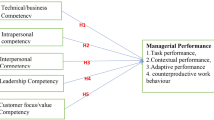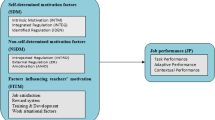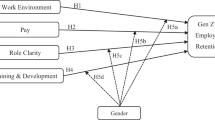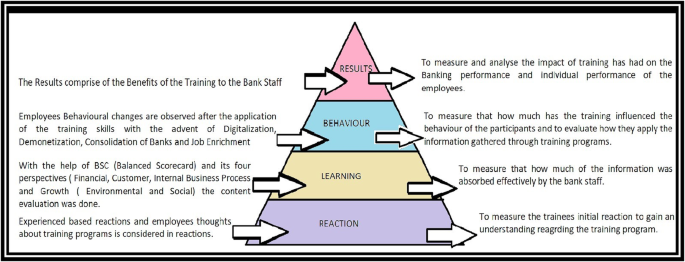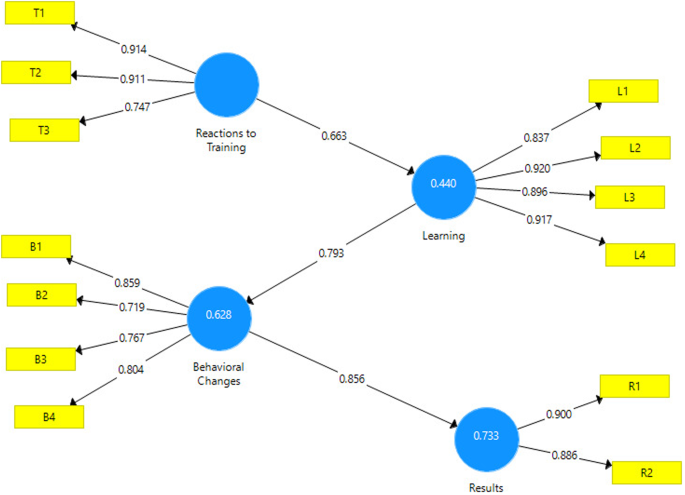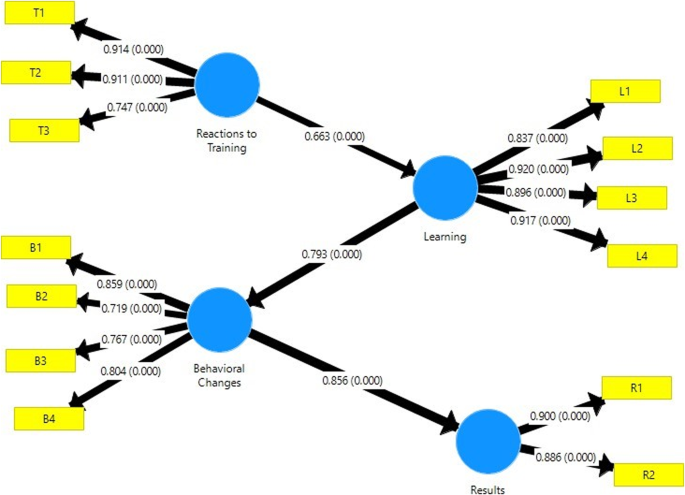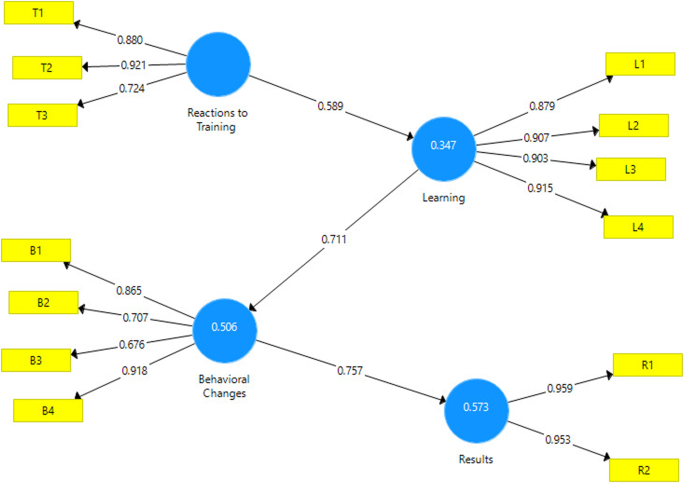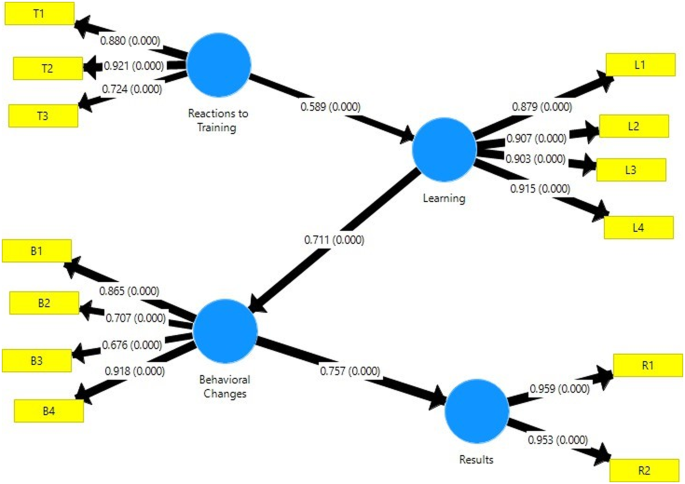Abstract
This research employs Kirkpatrick’s model, to assess the efficacy of training programmes for managerial and non-managerial employees in the banking sector using all the four components i.e., Reaction, Learning, Behavior and Results. Data were collected from 402 respondents from public, private and foreign sector banks. SEM-PLS was used to determine the relationship between the levels of the Kirkpatrick’s model for the evaluation of the training programs of the baking sector. The results suggest that all the four levels are interlinked and Kirkpatrick model was effective to evaluate the impact of training programs on employee motivation and bank performance. Reactions of employees (stage 1) have enhanced knowledge, and skills and has a positive and significant influence on learning (stage 2) and Behavior through job performance (stage 3) has a positive impact on results (stage 4). The results reflected that the adjusted R2 = 0.732 of the managerial level is more than that of the non-managerial level (R2 = 0.571). This indicates that the training is more effective on the Managerial level than the Non-Managerial level and that the managerial employees are more skilled and experienced in their jobs. The study is novel and one of the initial contributions to apply Kirkpatrick’s model to banking sector in India.
Similar content being viewed by others
Introduction
Training is crucial for enhancing employee development by emphasizing productivity optimization to meet customer satisfaction. Banks regard it as the utmost crucial objective. Employee training involves implementing programmes that provide individuals with the requisite knowledge and skills to effectively carry out a particular job or to acquire additional competencies in anticipation of future growth in their professional careers. It is a process that aligns the growth of the employee with the goals and procedures of the organization. The demand for employee training in banks has intensified as a result of the increasing competition in the banking sector. Evaluating the effectiveness of training programmes is a crucial priority for financial institutions. The Indian banking industry is currently facing substantial challenges arising from deregulation, demonetization, digitalization, and bank consolidation. These factors have intensified the need for job enrichment. Irrespective of their qualifications, every bank is required to offer their employees essential training. Induction or orientation is a compulsory training programme for all bank employees worldwide.
Banks are employing supplementary training programmes, in addition to induction programmes, to acquaint their employees with specific skills in anticipation of the introduction of e-banking. The dynamic nature of the environment has required an evaluation of the employee training and development programmes. Rani and Garg (2014) argue that it is extremely important to create a training culture that is integrated and systematic among bank employees, rather than providing training on an as-needed basis. According to Das (2018), it is crucial for financial institutions to establish a training system that is comprehensive and includes both quantitative and qualitative elements. In order to accomplish this, it is imperative to create specialized software for skill training and recruit the most highly qualified trainers available to incentivize them to engage in research and cultivate expertize. Furthermore, it is imperative to establish a proficient system for appraising training requirements and assessing performance. The need for enhanced training facilities and evaluation methods in the banking industry highlights the importance of creating a model that can accurately identify the required conditions to reflect the current state of banks.
Kirkpatrick’s Model, developed in 1954, made a substantial contribution to the formulation of strategies aimed at ensuring the acquisition of behavior and skills. The present study assessed the training programmes for banking employees utilizing Kirkpatrick’s four-tiered model. Employing Kirkpatrick’s model for evaluation is crucial for gauging the overall efficacy. This will streamline the process of evaluating whether to continue with the training programme, terminate it, or make any required modifications. The study elucidates the utilization of Kirkpatrick’s model to develop a framework that is effective for the banking sector to evaluate the effectiveness of training for bank employees and to measure the influence of that training on their behavioral results.
The present study is further classified on the basis of the objectives given below:
O1: To examine the reactions of the employees on their learning ability, learning on the behavioral changes of the employees and the impact of the Behavior on the overall Results of the training.
O2: To analyze the impact of training on the Managerial and the Non-Managerial levels of the Banking Sector
O3: To create a Model based on the impact of reactions on learning ability, learning on the behavior of the employees and finally analyzing the results to incorporate changes in the training program separately for both the Managerial and the Non-Managerial levels.
Many researchers employ Kirkpatrick’s Model to evaluate training programmes. As the level of evaluation increases, the process becomes more difficult and time-consuming. The banking industry, being a major contributor to the global gross domestic product, has created employment opportunities for billions of individuals across the globe. Therefore, it is the responsibility of financial institutions to make sure that their staff members receive sufficient training and that the training programmes are regularly evaluated. Training the current staff is a more cost-effective option compared to hiring a high-priced professional. Training is a means by which employees gain organized knowledge to enhance their skills, growth, and cultivate a favorable mindset towards carrying out a particular job. Proficient employees are crucial to a company’s success (Mathur and Pandaya, 2019). The significance of offering employees timely and pertinent training is emphasized by the scarcity of resources and the increasing expectations, as elucidated by Benson and Dundis (2003). Despite assessment being a crucial component of staff training processes, Rajeev et al. (2009) claim that training programmes are inconsistent and lacking in adequate evaluation. Therefore, drawing from these viewpoints, the present study endeavors to offer a response to the subsequent research question:
Does data from training program implemented at the banking industry support the use of Kirkpatrick’s Model for evaluation (Kirkpatrick and Kirkpatrick, 2006)?
The following is the outline of the article. In “Introduction”, we build on what has been learned from the previous literature to show how important the training programmes are and to argue that they should be regularized soon so that performance and results can improve. This section also explains the original Kirkpatrick’s model and how the study built upon it to use a conceptual model to evaluate the impact of training programmes for bank employees. “Literature Review” details a review of previous research that focused on how training affected the outcomes for scientists who have used Kirkpatrick’s Model. “Theoretical Underpinning and hypotheses development” then moves on to talk about how theories and hypotheses development. Also included here is a comprehensive rundown of all the steps needed to evaluate the training methods. “Research Design and Methodology” details the study’s population, sample, scale, and methodology. Using the four stages of Kirkpatrick’s Model—Reaction, Learning, Behavior, and Results—this study aims to construct a PLS-SEM-based model to evaluate training programmes. “Data analysis” provides a comprehensive summary of the investigation’s findings. Discussion, limitations, implications, and suggestions for further study make up “Discussion and conclusion”.
Literature review
Evaluation of training entails systematically reviewing descriptive and judgmental data necessary for making good training decisions (Werner and DeSimone, 2012). Assessing the impact of training on the behavioral modifications of the organization’s employees is one of the main procedures to determine the efficacy of the training. An in-depth assessment is required for every training programme before its worth can be determined. The training has a significant impact on how employees behave within an organization. Employees’ improved behavior is a direct result of their training’s emphasis on knowledge retention, skill development, and situational awareness. According to Mohamed et al. (2012), when it comes to assessing training programmes, Kirkpatrick’s Model works well for knowledge transfer from the individual to the workplace. In the 50 years after its inception, Kirkpatrick’s model has remained the gold standard for assessing the efficacy of training (Saxena, 2020). Evaluating training in the banking industry should focus more on the training itself, not just the results, to increase the effectiveness of training for employees. As a result, this study used Kirkpatrick’s four-leveled model to evaluate the training procedure’s effectiveness.
The current study utilized the conceptual framework of Kirkpatrick’s Model (Fig. 1) to analyse the impact of training on the banking staff. The evaluation process is broken down into four separate steps according to the Kirkpatrick model. Included in this category are Reactions, Behavior, Learning, and Outcome. Training evaluation is important and crucial because if the results aren’t what were hoped for, then the whole training process was a waste of time and money. Overall, the research has used all four levels of Kirkpatrick’s Model to evaluate the benefits of training programmes in the banking industry. Adapted from Kirkpatrick’s model, Fig. 1 shows the stages used to evaluate the effectiveness of training for banking sector employees. Employee reactions to the training itself make up the first phase. The next step is to put all that training into practice by learning new things that are relevant to what you already know. In the third phase, workers adjust their actions in accordance with what they’ve learned and how they’ve handled certain situations so that the bank can run more smoothly. The last step is to evaluate the findings in the context of the overall efficiency and effectiveness of the banking industry and its personnel.
In Level 1 the reactions of the employees to the training programs are considered and measured for further imparting in depth information and skills. Level 1 consists of the various training programs i.e., On the Job training, Off the Job training and Special training being imparted to the trainees and to observe their reactions for the same.
Level 2 consists of the Learning and absorbing the information being imparted with the help of BSC (Balanced Score Card) and its four perspectives i.e., Financial, Customer, Internal Business Process and Growth (Social and Environmental) perspectives.
Level 3 consists of the behavioral changes as a result of the factors affecting the Banking environment and job performance w.r.t. Digitalization, Demonetization, Job Enrichment; and Consolidation of banks.
Level 4 concludes with results for assessing the training programmes’ overall effectiveness, as measured by the benefits to employee motivation and bank performance.
Literature support and application of Kirkpatrick model in different sectors is depicted through Table 1.
Theoretical underpinning and hypotheses development
The purpose of this research is to look at how the four stages of Kirkpatrick’s Model (Reactions, Learning, and Behavior) interact with each other. This research set out to clarify how these phases differ at the managerial and non-managerial echelons.
In order to compare how well the three different training methods employed, we use the first level of Kirkpatrick’s model. Employees’ knowledge, attitudes, behaviors, and performance are all improved through on-the-job training. Creative output, goal attainment, and monetary gain are all profoundly affected. According to Lin and Hsu (2017), there is a positive relation between on-the-job training and employees’ work performance, personality traits, work behavior, and overall job achievement. Lynch (2014) found the opposite to be true: that off-the-job training increases the probability of employee turnover, while on-the-job training increases tenure. Since off-the-job training is more targeted and on-the-job training is broad, he argues that women are more inclined to quit an employer when it comes to the former. It is essential to provide staff with specialized training to help them interact with customers effectively, according to Ali and Ratwani (2017), because employees’ attitudes change and vary in response to customer demands. Workers are empowered to perform to their full potential when they have access to a well-crafted training programme.
H1: There is a difference in reactions to different forms of training (On the Job, Off the Job and Special training) for managerial and non-managerial employees.
H1a: There is a difference in reactions to different forms of training (On the Job, Off the Job and Special training) for managerial employees.
H1b: There is a difference in reactions to different forms of training (On the Job, Off the Job and Special training) for non-managerial employees.
Kirkpatrick’s model associates Level 2 with learning based on training. There can be no greater importance than figuring out how much training has improved knowledge and abilities to positively impact learning. Although there are a variety of models that can be used to evaluate learning, the balanced score card (BSC) is used in this study to examine how reactions impact learning. According to Tuan’s (2020) research, commercial banks in Vietnam saw substantial gains in performance after adopting the balanced scorecard as an evaluation tool. Organizations can benefit from BSC because it allows for more balanced evaluations of bank and employee performance in addition to overall company performance. Consequently, the BSC and its four perspectives greatly influence employee performance because they make it easier to evaluate their learning capacity.
H2: There is a difference in the learning ability of managerial and non-managerial employees for the four perspectives, viz. financial, internal business process, customer and growth (social and environmental) perspectives.
H3: The reactions to the training (Level 1) has a significant influence on learning (Level 2).
H3a: The reactions to the training (Level 1) has a significant influence on learning (Level 2) for the managerial employees.
H3b: The reactions to the training (Level 1) has a significant influence on learning (Level 1) for the non-managerial employees.
In Kirkpatrick’s model, the impact of actions on productivity in the workplace is investigated at the third level. Thanks to this insightful evaluation data, we can improve the training programmes with confidence. We looked at it in this study by analyzing the efforts of the employees to adjust to the constantly shifting business climate, which encompassed digitalization, demonetization, and bank consolidation. Furthermore, it tackles diversity through enhancing job opportunities. The factors that impact performance and the ways in which employees cope with these factors are the causes of behavioral changes. Workers in the banking industry have been able to improve their efficiency, manage customer relations better, offer services that go beyond their physical capabilities, and handle information management more effectively thanks to digitalization. Based on statistical evidence presented by AL-Ahdal et al. (2018), demonetization had a substantial impact on the firm’s financial performance. Zunzunegui (2018) asserts that modern banks give their customers more control over their personal data, which they can then use in partnership with tech companies to improve their services and earn their trust. A number of elements affect employee motivation, including job enrichment, pay, and training opportunities. Each company needs to find a good way to pay their employees and provide them opportunities to grow professionally and personally (Tumi et al. 2021). When it comes to banking institutions, high-performance work systems are a great way to boost productivity and output.
Since the merged banks are still following all applicable laws and regulations, Prakash et al. (2018) state that consolidation has had no effect on the long-term viability of the banking industry. Declining production, branch closures, unregulated customer service, and increased employee workload are the main challenges facing India’s baking industry. Just as Kambar (2019) asserted. The current research looks at how employees’ actions are correlated with their attempts to adjust to ever-changing corporate conditions, including digitalization, demonetization, bank consolidation, and job enrichment, in order to evaluate performance at this level.
H4: There is a difference in the Behavioral changes of managerial and non-managerial employees w.r.t to the factors influencing the functioning of the banks (Digitalization, Demonetization, Job Enrichment and Consolidation of Banks).
H5a: Learning (level 2) has a significant influence on Behavioral changes (level3) of the managerial and non- managerial employees.
H5a: Learning (level 2) has a significant influence on Behavioral changes (level3) of the managerial employees.
H5b: Learning (level2) has a significant influence on Behavioral changes (level 3) of the non-managerial employees.
Training has several positive effects on performance, including but not limited to: employees’ capacity for self-management, technical skill development, cross-cultural competence, innovation, and tacit expertize (Aguinis and Kraiger, 2009). Methods used to educate employees have a significant impact on a company’s image (Clady, 2018). Benefits include individual and team financial health as well as national financial health (Janev et al., 2018).
To get the most out of training, it’s important to pay attention to the following: need assessment, trainees’ pre-training state, training design and delivery, training evaluation, and training transfer. Providing training to employees has many benefits, but only if the evaluation is done correctly. Therefore, it is necessary to investigate the benefits of training in relation to the performance of the bank and the motivation of its employees. A well-organized training programme is essential for all employees, including those in managerial and non-management roles. At the managerial levels, competences and skills matter greatly. Finding qualified candidates for managerial positions at all levels is difficult for most companies. Aslan and Pamukcu (2017) opine managers are in a position to make choices that might have a major impact on their employees’ emotional and physical well-being. Training that takes place in an organizational context also has an effect on the managers’ mental health and their level of competence. The authors of the study are Yahya and colleagues (2018). Therefore, it is highly beneficial to have a structured training programme for managers in the banking sector. Research into the impacts of development and training programmes on banking industry managers and non-managers is, therefore, essential, as is an evaluation of the present training programmes’ ability to boost productivity in the banking sector.
H6: Behavioral changes (level 3) has a significant impact on the results, viz. individual and bank performance (level 4) for managerial and non-managerial employees.
H6a: Behavioral changes (level 3) has a significant impact on the results, viz. individual and bank performance (level 4) for managerial employees.
H6b: Behavioral changes (level 3) has a significant impact on the results, viz. individual and bank performance (level 4) for non-managerial employees.
H7: Training has a significant impact on results, viz. individual and bank performance for managerial as well as non-managerial employees.
H7a: Training has a significant impact on results, viz. individual and bank performance for managerial employees.
H7b: Training has a significant impact on results, viz. individual and bank performance for the non-managerial employees.
The next stage is to give details of dataset, research design and methodology. This has been covered in “Data analysis”.
Research design and methodology
Target population and sample size
Data for the present study were gathered from employees of public, private, and foreign sector banks via a structured questionnaire. The responses pertain to the banks’ contribution to the Indian economy, with public sector banks accounting for 66%, and private sector banks for 28% and foreign banks 6%. A grand total of 402 responses were gathered for the purpose of analysis and interpretation, despite the data collection being impeded by the Covid-19 pandemic. There are 125 banks from the public sector, 55 banks from the private sector, and 15 foreign banks included in the count. The research encompasses the following financial institutions: Axis, Punjab National Bank, SIDBI, IDBI, Yes Bank, J & K bank, Canara, Punjab and Sind Bank, Punjab Gramin Bank, Syndicate Bank, and State Bank of India. Branch heads, assistant managers, regional heads, senior managers, associates, probationary officers, clerks, and chief managers were among the personnel affected. A further division was made into level 1 (managerial personnel) and level 2 (non-managerial personnel). The primary objective of this research is to utilize Kirkpatrick’s Model in order to improve the efficiency of training programmes for managerial and non-managerial personnel in the banking industry.
Research methods
The current investigation employed PLS-SEM model to ascertain the proposed measurement and structural model, which is a widely recognized and utilized technique across multiple research domains. Legate et al. (2023) found that for many years, Covariance-based Structural Equation Modeling (CB-SEM) has been the method of choice for interpreting intricate interrelationships between latent and observed variables. In 2010, a relatively greater number of published articles incorporated PLS-SEM, as reported by Hair et al. (2017). Perceptron-Last SEM (PLS-SEM) is a causal predictive methodology within SEM that prioritizes prediction when assessing statistical models designed to provide imaginative explanations (Wold, 1982; Sarstedt et al., 2017). PLS-SEM is typically applied to data with non-normal distribution and small sample sizes. It facilitates the estimation of values for numerous interdependent relationships among variables and the application of construct measurement (Ittner et al. 1997). Given the limited sample size, extensive application, and general acceptance of PLS-SEM, it was deemed appropriate to utilize this method to assess the efficacy of training in the banking industry.
Data analysis
Kirkpatrick’s model for evaluation of effectiveness of training for managerial employees
Measurement model
Reliability and validity
Before analyzing Kirkpatrick’s model’s four tiers, construct reliability and validity have been assessed. According to Fornell and Larcker (1981), factor loadings and average variance extracted (AVE) are used to assess construct convergent validity. Table 2 shows that the AVE ranges from 0.623 to 0.799, meeting Brown and Moore (2012)‘s threshold. Nunnally (1978) considered composite reliability (CR) values acceptable if they meet 0.70. Cronbach Alpha values range from 0.748 to 0.915, while composite reliability is 0.868 to 0.940. The model has acceptable construct validity and reliability.
Discriminant validity
Discriminant validity was determined by comparing square root of AVE values to inner construct correlations. Table 3 shows that square root of AVE was greater than construct correlations, indicating acceptable discriminant validity. The HTMT criterion aids discriminant validity assessment. As per HTMT criterion, the acceptable level of discriminant validity is suggested to be less than 0.90 between reflective constructs (Hair and Alamer, 2022). Kirkpatrick’s Model’s four stages had values below 0.90. Thus, discriminant validity between variables is established. Given that all the stipulations have been fulfilled, it was deemed suitable to proceed with the analysis.
Variance inflation factor
Variance Inflation Factor VIF values greater than 3 reflect the presence of collinearity (Hair, Ringle and Sarstedt 2011). As reflected through Table 4, all VIF values are all lesser than the threshold limit of 3, therefore no indicator was removed.
The study was done with the major objective to examine the effectiveness of training on managerial employees with the help of Kirkpatrick model, basically to examine the impact of training programs on results, viz. employee motivation and bank performance (Table 5). Before continuing structural modeling, all factor outer loadings must be checked. All factors had significant values (p ≤ 0.01) and values above 0.70 (threshold level). No factor was eliminated.
The four levels of Kirkpatrick model are: reaction to training; learning w.r.t. financial, internal business process, customer and growth (social and environmental) perspectives; behavior; and results were taken to analyze the impact of training on the performance of the employees and bank performance (Fig. 2). This study examined how reactions affected on-the-job, off-the-job, and special training programmes. The initial hypothesis: H1: There is a difference in reactions to different forms of training (On the Job, Off the Job and Special training) for managerial and non-managerial employees. Table 6 shows that on-the-job training has 0.914 outer weights, off-the-job training 0.911, and special training 0.747. Each is significant and greater than 0.70. Of these three types of training, off-the-job training loaded more items. The least loadings were for special training. H1a: Managerial employees react differently to on-the-job, off-the-job, and special training has been accepted. Findings highlight that special training, which had lower outer weights requires added focus.
The next objective was to assess how much information was retained and whether the training led to financial, customer, internal business process, and growth (social and environmental) learning. The related hypothesis is H2: There is a difference in the learning ability of managerial and non-managerial employees for the four perspectives, viz. financial, internal business process, customer and growth (social and environmental) perspectives. The outer loadings of all four learning perspectives were greater than 0.70, between 0.837 and 0.920, and significant. Thus, the training taught financial, customer, internal business process, and growth (social and environmental) perspectives. Hence H2 has been empirically supported and there is a difference in the learning ability of managerial employees for the four perspectives, viz. financial, internal business process, customer and growth (social and environmental) perspectives at the managerial level.
The next hypothesis linking stage 1 reactions to training to level 2 learning is H3: The reactions to the training (Level 1) has a significant influence on learning (Level 2). As we can see from path co-efficient given in Table 6 and PLS-SEM Fig. 2, the Beta value for Reactions to Training -> Learning is 0.663 and is significant (T:14.366; p ≤ 0.01). Thus, the reactions to the training (Level 1) has a significant influence on learning (level 2) has been empirically supported.
The third objective of the study was to measure how much training has influenced learning and how learning has influenced employee behavior to evaluate their application of information to deal with factors influencing the banking environment and employee performance, such as digitalization, demonetization, bank consolidation, and job enrichment. This study examined whether behavioral changes helped employees cope with dynamic bank performance factors. The outer weights indicate that employees struggled with demonetization and bank consolidation. These two are recent and may require training. Thus, this must be addressed. Results show that job enrichment and digitalization are more important. New training modules should cover bank consolidation and demonetization. Hence, we can say that hypothesis H4: There is a difference in the Behavioral changes of managerial employees w.r.t to the factors influencing the banks (Digitalization, Demonetization, Job Enrichment and Consolidation of Banks) has been accepted.
The next hypothesis was linking learning with Behavioral changes. As we can see from path co-efficient given in Table 6 and PLS-SEM Fig. 2, the Beta value for Learning -> Behavioral changes is 0.663 and is significant (T: 21.931; p ≤ 0.01). Thus, H5a: Learning (level 2) has a significant influence on Behavioral changes (level3) of the managerial employees had been empirically supported.
Lastly, the results were measured and analyzed to observe whether the Behavioral changes through job performance (level 3) have a positive impact on results, viz. employee motivation and bank performance (level 4). Outer weights of benefits in terms of employee motivation and bank performance are quite high. Moreover, the Beta value for Behavioral changes -> Results is 0.856 and is significant (T: 35.409; p ≤ 0.01). On the basis of these results, we accept H6a: Behavioral changes (level 3) has a significant impact on the results, viz. individual and bank performance (level 4) for managerial employees.
The highlighted paths of bootstrapping results are shown through Fig. 3. All paths are significant as indicated through the Fig. 3.
The last hypothesis is H7a: Training has a significant impact on results, viz. individual and bank performance for managerial employees. The effectiveness of training for managerial employees can be gauged from the R2 value of 0.733 and adj. R2 value of 0.732 suggesting that this model for managers explains 73.2% of total variation. The total effects are also shown through Table 7, highlight Reactions to Training -> Learning (0.663); Reactions to Training -> Behavioral Changes (0.526) and Reactions to Training -> Results (0.450) are all significant. Further Learning -> Behavioral Changes (0.793) and Learning -> Results (0.679) are also positive and significant. Lastly, Behavioral Changes -> Results. The beta value is high (0.856) and is also positive and significant. Training-related learning, behavioral changes, and results are all important. Behavioral changes and results from further learning are also positive and significant. Last, Behavioral Changes -> Results is positive and significant. Thus, H7a is empirically supported. The training programmes improved employees’ skills to cope with the dynamic banking sector and factors affecting bank performance, which significantly impacted employee motivation and bank performance.
Kirkpatrick’s model for evaluation of effectiveness of training for non-managerial employees
Reliability and validity
For the four levels of Kirkpatrick’s model, it is vital to assess the reliability and validity of constructs for non-managerial level. The non-managerial model has AVE between 0.637 and 0.914 (Table 8). Composite reliability is 0.873–0.945 and Cronbach Alpha is 0.805–0.923. Model construct validity and reliability are good for non-managerial level too.
Discriminant validity
As shown through Table 9, the discriminant validity is also acceptable for non-managerial employees. The square of AVE values is higher than inner construct correlations and HTMT ratios are below 0.90 and are thus acceptable.
Variance inflation factor
Variance Inflation Factor VIF values should not exceed 3. The absence of collinearity is illustrated in Table 10 for the outer VIF are less than 3 (Hair, Ringle, and Sarstedt, 2011). Thus, we proceeded with all indicators, for further analysis.
The initial hypothesis associated with the Kirkpatrick model for assessing the impact of training on outcomes is as follows: H1b: Non-managerial employees exhibit distinct responses to various types of training (on-the-job, off-the-job, and special training). The outer weights for On-the-Job training (0.880), Off-the-Job training (0.921), and Special Training (0.724) are detailed in Table 11. This indicates that employees at the non-managerial level place greater importance on off-the-job training, as it carries the highest loading. This differs from managerial levels, where on-the-job training carries a greater workload. The fact that special training entails reduced workloads for both managerial and non-managerial personnel may suggest that these aspects should be prioritized in future efforts to enhance this form of training. Specialized training is in greater need of attention in light of recent developments in the banking industry. Nonetheless, all of these values exceed 0.70 and were thus significant. As a result, the hypothesis H1b, which states that non-managerial employees respond differently to various types of training (on-the-job, off-the-job, and special training), is supported. At banks, it is time to transition from routine orientation programmes to alternative formats.
The next objective was to investigate the relationship between responses to training (Level 1) and learning (Level 2), specifically from the perspectives of finance, customers, internal business processes, and growth (social and environmental aspects). H2b: There is a difference in the learning ability of non-managerial employees for the four perspectives, viz. financial, internal business process, customer and growth (social and environmental) perspectives. The outer loadings of all the four perspectives of learning were greater than 0.70, in the range of 0.879 and 0.915 with p ≤ 0.01. Hence, it can be inferred that the training led to learning from financial; customer; internal business process; and growth (social and environmental) perspectives. Hence, this hypothesis has been empirically supported for non-managerial employees. The third hypothesis was whether reactions to training (level) were influencing level 2 learning. As we can see from path co-efficient given in Table 12 and Fig. 4, the Beta value for Reactions to Training ->Learning is 0.589 and is significant (T: 14.058; p ≤ 0.01). Therefore, H3b, which states that non-managerial employees’ reactions to the training (Level 1) have a substantial impact on their learning (Level 2), is supported by empirical evidence.
After analyzing relation between reactions to training to learning, the next step was to relate learning with behavior. It was to examine whether this learning through behavioral changes helped employees to deal effectively with the dynamic factors, viz. Digitalization, Demonetization, Consolidation of banks and behavioral changes related with Job Enrichment. The loadings for behavioral changes related with Job Enrichment had highest loading indicating its supremacy. From behavioral changes related Consolidation of banks, had the lowest loading, and Demonetization to had lesser loading, indicating that non-managerial employees were not dealing with Consolidation of banks and demonetization effectively. Consequently, we can say that hypothesis H4: There is a difference in the Behavioral changes of non-managerial employees w.r.t to the factors influencing the banks (Digitalization, Demonetization, Job Enrichment and Consolidation of Banks) has been accepted.
The next hypothesis was to see whether learning is related with Behavioral changes. As we can see from path co-efficient given in Table 12 and Fig. 4, the Beta value for Learning -> Behavioral changes is 0.711 and is significant (T:17.485; p ≤ 0.01). Thus, H5a: Learning (level 2) has a significant influence on Behavioral changes (level3) of the non-managerial employees had been empirically supported.
It is vital to access whether the Behavioral changes through job performance (level 3) have a positive impact on results, viz. employee motivation and bank performance (level 4). Outer loadings of benefits in terms of employee motivation and bank performance are quite high. Moreover, the Beta value for Behavioral changes -> Results is 0.757 and is significant (T:20.302; p ≤ 0.01). On the basis of these results, we accept H6b: Behavioral changes (level 3) have a significant impact on the results, viz. individual and bank performance (level 4) for non-managerial employees. The highlighted paths of bootstrapping results are shown through Fig. 5. All paths are significant as indicated through the Fig. 5.
The last hypothesis related with non-managerial employees is H7b: Training has a significant impact on results, viz. individual and bank performance for managerial employees. From R2 Value of 0.573 and adj. R2 Value of 0.571, it can be indicated that model for non-managers explains 57.1% of total variation. The total effects are also shown through Table 13. As reflected, Reactions to Training -> Learning (0.589); Reactions to Training -> Behavioral Changes (0.419) and Reactions to Training -> Results (0.317) are all significant. Further Learning -> Behavioral Changes (0.711) and Learning -> Results (0.539) are also positive and significant. Lastly, Behavioral Changes -> Results. The beta value is high (0.757) and is also positive and significant. Hence hypothesis H7b: Training has a significant impact on results, viz. individual and bank performance for managerial employees has been empirically supported. Thus, on the basis of these results, it can be concluded that the training programs were effective as reflected through all stages of Kirkpatrick model. Till yet, very little research covers gauging effectiveness of training using Kirkpatrick model. This study has set the stage, where the differences at managerial and non-managerial level may be considered to enhance the effectiveness of training.
Overall results highlight that in case of managerial model the R2 = 0.733 and the adjusted R2 = 0.732 are higher than that for the non-managerial level with R2 = 0.573 and adjusted R2 = 0.571. This indicates that the training is effective for both the managerial level than the non-managerial level, but is more successful for managerial employees.
Discussion and conclusion
The findings provide evidence that responses to training influence learning, learning influences behavior, and behavior influences the overall outcomes (Table 14). Training must be linked to determinants such as demonetization, consolidation of banks, and digitization, which have a significant impact on the overall banking environment. Additionally, job enrichment must be taken-into-account, particularly when attempting to influence behavior. Four perspectives are utilized to analyse the employees’ favorable response to receiving training and assimilating the information through learning for application: financial, internal business process, customer, and growth (social and environmental). The efficacy of training programmes as a whole is demonstrated by the outcomes of training benefits. The researchers in this particular domain hold optimistic views regarding the performance of banks; however, as each passing phase in this sector unfolds, evaluation methods must be improved. Kirkpatrick’s model is widely utilized as a standard for assessing programmes across diverse industries, including but not limited to the pharmaceutical, medical, and aviation sectors (Li et al. 2020; Firooznia et al. 2020; Buriak and Ayars, 2019; Mishra et al. 2020). Diverse departments have implemented the various phases of Kirkpatrick’s Model of Training Evaluation both collectively and individually. However, the number of studies that have contributed to the evaluation of training in the banking industry is negligible, rendering it a pertinent subject for discourse.
The current investigation aids in the assessment of training in the banking industry and derives its conclusions from the primary data gathered from 402 respondents. The study is predicated on an examination of the determinants of bank performance, namely consolidation of banks, demonetization, and digitization, as well as job enrichment. Additionally, the types of training provided by banks, including on-the-job training, off-the-job training, and special training, are considered. Numerous autonomous investigations have been conducted on the correlation between Kirkpatrick’s Model and the determinants of bank performance. However, this scholarly article capitalizes on the training’s merits and examines the aforementioned factors before employing the Kirkpatrick’s Model for Evaluation of Training Programmes to assess the effectiveness of the training programmes. In addition, the results emphasize the importance of special training in the management of demonetization and bank consolidation. Nonetheless, it does underscore the correlation between bank performance and employee motivation resulting from training programmes. Therefore, it can be deduced that the Kirkpatrick model demonstrated efficacy in assessing the effects of training programmes on outcomes, behavior, and learning.
Practical implications
The results of the study indicate that there is an urgent need to train banking sector employees in accordance with their managerial and non-managerial positions, and that the training they are currently receiving is producing significant results. The training initiatives implemented within the banking industry exert a substantial influence on the behavior of personnel. In response to change drivers, the managerial level is subject to a greater number of changes than the non-managerial level. In light of the findings of this study, it is imperative that special training be emphasized in order to facilitate a more effective response to the dynamic changes occurring in the banking sector, particularly in regards to demonetization, consolidation of banks, and digitalization (which are change drivers). The study suggests that there is a necessity to concentrate on comprehending the potential efficacy of training through behavioral modifications and learning in order to improve job performance and the overall performance of the bank for both managerial and non-managerial staff.
Limitations and future scope
This study is based on a sample of 402 respondents. An expansion of the sample size could be considered in order to assess the comprehensive efficacy of the training. An expansion of the research could involve conducting a bank-by-bank examination of training programmes and assessing their influence on performance. Korde and Laghate (2015) assert that training and development programmes have a significant influence on the performance of banks. However, further research is required to compare the effects of training programmes in private and public sector banks and to offer recommendations. Based on an analysis of training responses and performance indicators across various banking sectors, the present study concludes that while training is advantageous for all sectors, managerial level employees in the banking industry necessitate particular attention in terms of training needs and self-improvement. Subsequent research may additionally account for the variations in training programmes, construct an industry-specific model, and derive conclusions. Drawing distinctions and developing a model based on an analysis of the current training environment in the banking industry are facilitated by the present study.
Data availability
The data supporting the findings of the study are available from the corresponding authors upon reasonable request.
References
Abdelhakim AS, Jones E, Redmond EC, Griffith CJ, Hewedi M (2018) Evaluating cabin crew food safety training using the Kirkpatrick model: an airlines’ perspective. Br Food J 120(7):1574–1589
Aguinis H, Kraiger K (2009) Benefits of training and development for individuals and teams, organizations, and society. Annu Rev Psychol 60(1):451–474
Al-ahdal WM, Prusty T (2018) The impact of demonetization on Indian firms’ performance: does company’s age make a difference? Invest Manag Financ Innov 15(3):71
Ali A, Ratwani B (2017) Customers’ satisfaction in Indian banks: problems and solutions. Int J Econom Res 14(9):69–76
Aryadoust V (2017) Adapting Levels 1 and 2 of Kirkpatrick’s model of training evaluation to examine the effectiveness of a tertiary-level writing course. Pedagogies: Int J 12(2):151–179
Aslan M, Pamukcu A (2017) Managerial competencies and impact on management levels. Int J Adv Res Manag Soc Sci 6(9):1–15
Baskin C (2001) Using Kirkpatrick’s four-level-evaluation model to explore the effectiveness of collaborative online group work. In Proceedings of the Annual Conference of the Australasian Society for Computers in Learning in Tertiary Education (pp. 9–12)
Benson SG, Dundis SP (2003) Understanding and motivating health care employees: integrating Maslow’s hierarchy of needs, training and technology. J Nurs Manag 11(5):315–320
Bijani M, Rostami K, Momennasab M, Yektatalab S (2018) Evaluating the effectiveness of a continuing education program for prevention of occupational exposure to needle stick injuries in nursing staff based on Kirkpatrick’s Model. J Natl Med Assoc 110(5):459–463
Brown TA, Moore MT (2012) Confirmatory factor analysis. Handb Struct Equ Model 361:379
Buriak SE, Ayars CL (2019) Evaluation of a drug and alcohol safety education program in aviation using interrupted time series and the Kirkpatrick framework. Eval Progr Plan. 73:62–70
Clardy A (2018) 70-20-10 and the dominance of informal learning: a fact in search of evidence. Hum Resour Dev Rev17(2):153–178
Das B (2018) Training and development of bank employees. Int J Res Eng Appl. Manag 4(2):2454–9150
Firooznia M, Hamta A, Shakerian S (2020) The effectiveness of in-service training “pharmacopeia home health” based on Kirkpatrick’s model: A quasi-experimental study. J Edu Health Promotion 9(1):218
Fornell C, Larcker DF (1981) “Structural equation models with unobservable variables and measurement error: Algebra and statistics.” 382–388
Hair JF, Ringle CM, Sarstedt M (2011) PLS-SEM: Indeed a silver bullet. J Market theory Pract 19(2):139–152
Hair JF, Hult GTM, Ringle CM, Sarstedt M, Thiele KO (2017) Mirror, mirror on the wall: a comparative evaluation of composite-based structural equation modeling methods. J Acad Mark Sci 45(5):616–632
Hair J, Alamer A (2022) Partial Least Squares Structural Equation Modeling (PLS-SEM) in second language and education research: Guidelines using an applied example. Res Methods Appl Linguist 1(3):100027
Hamtini TM (2008) Evaluating e-learning programs: An adaptation of Kirkpatrick’s model to accommodate e-learning environments. J Comput Sci 4(8):693
Ittner CD, Larcker DF, Rajan MV (1997) The choice of performance measures in annual bonus contracts. Accounting Review, 231–255
Janev I, Hadzi-Vasileva G, Sofijanova E (2018) Benefits of training and development for individuals, teams and organizations. J Econ 3(1):12–18
Kambar PS (2019) A study on the consolidation and merger of public sector banks (PSB) in India: issues and challenges. Int J Soc Sci Econ Res 4(6):4326–4334
Kirkpatrick D, Kirkpatrick J (2006) Evaluating training programs: The four levels. Berrett-Koehler Publishers
Korde A, Laghate K (2015) Is there any impact of training on the performance of selected public sector banks. Symbiosis Cent Manag Stud 3:135–154
Legate AE, Hair JF, Chretien J L, Risher JJ (2023) PLS‐SEM: Prediction‐oriented solutions for HRD researchers. Hum Resour Dev Quart 34(1):91–109
Li Z, Cheng J, Zhou T, Wang S, Huang S, Wang H (2020) Evaluating a nurse training program in the emergency surgery department based on the Kirkpatrick’s model and clinical demand during the COVID-19 pandemic. Telemed e-Health 26(8):985–991
Lin SR, Hsu CC (2017) A study of impact on-job training on job performance of employees in catering industry. Int J Organ Innov (Online) 9(3):125A
Lynch L (2014) Renewing employment relations for shared prosperity. LERA For Libraries, 18
Mathur N, Pandya T (2019) Analysis of training practices in public sector banks for professional development, effectiveness and return on investment with reference to south Rajasthan
Mishra US, Mohapatra SS, Pattanayak S (2020) Employee Training Creating Growth of Hotel Industry in India: The Mediating Role of Employee Performance
Mohamed R, Alias AAS (2012) Evaluating the effectiveness of a training program using the four level Kirkpatrick model in the banking sector in malaysia
Moldovan L (2016) Training outcome evaluation model. Procedia Technol. 22:1184–1190
Nunnally JC (1978) An overview of psychological measurement. Clinical diagnosis of mental disorders: A handbook, 97–146
Ozturan M, Kutlu B (2010) Employee satisfaction of corporate e-training programs. Procedia-Soc. Behav. Sci. 2(2):5561–5565
Passmore J, Velez MJ (2014) Training evaluation. The Wiley Blackwell handbook of the psychology of training, development, and performance improvement, 136–153
Prakash A, Kumar K, Srivastava A (2018) Consolidation in the Indian banking sector: evaluation of sustainable development readiness of the public sector banks in India. Int J Sustain Strategic Manag 6(1):3–16
Rafiq MRI (2016) Determining Bank performance using CAMEL rating: A comparative study on selected Islamic and Conventional Banks in Bangladesh. Asian Bus Rev 6(3):151–160
Rahman AAA, Yaacob MR, Ibrahim MAHB, Shaupi NSA (2019) Measuring the remode entreprenurship training programme at behaviour level of Kirkpatrick model in aquaculture industry
Rajeev P, Madan MS, Jayarajan K (2009) Revisiting Kirkpatrick’s model–an evaluation of an academic training course. Curr Sci, 272–276
Rani K, Garg D (2014) A study on training and development in public sector banks. Int. J. Manag. Soc. Sci. Res. 3(1):33–36
Rouse DN (2011) Employing Kirkpatrick’s evaluation framework to determine the effectiveness of health information management courses and programs. Perspectives in health information management, 8(Spring)
Sarstedt M, Ringle CM, Hair JF (2017) Treating unobserved heterogeneity in PLS-SEM: A multi-method approach. Partial least squares path modeling: Basic concepts, methodological issues and applications, 197–217
Saxena P (2020) A new model for training evaluation in the banking industry
Tan K, Newman E (2013) The evaluation of sales force training in retail organizations: a test of Kirkpatrick’s four-level model. Int. J. Manag. 30(2):692
Tuan TT (2020) The impact of balanced scorecard on performance: the case of Vietnamese commercial banks. J. Asian Financ., Econ. Bus. 7(1):71–79
Tumi NS, Hasan AN, Khalid J (2021) Impact of compensation, job enrichment and enlargement, and training on employee motivation. Bus Perspect Res 10(1):121–139
Ulum ÖG (2015) Program evaluation through Kirkpatrick’s framework. Online Submiss 8(1):106–111
Vizeshfar F, Momennasab M, Yektatalab S, Iman MT (2018) Evaluation of the effectiveness of a first aid health volunteers’ training programme using Kirkpatrick’s model: a pilot study. Health Educ J 77(2):190–197
Werner JM, DeSimone RL (2012) Human Resource Development. 6th International Edition. Cengage Learning, South-Western
Wold H (1982) ‘Soft Modeling: the basic design and some extentions’, in Jöreskog, KG and Wold, H (Eds): Systems under indirect observations: Part II, pp. 1–54, North-Holland, Amsterdam
Yahaya MH, Ahmad K (2018) Financial inclusion through efficient zakat distribution for poverty alleviation in Malaysia: Using fintech & mobile banking. In Proceeding of the 5th International Conference on Management and Muamalah (pp. 15-31)
Yi ZM, Zhou LY, Yang L, Yang L, Liu W, Zhao RS, Zhai SD (2020) Effect of the international pharmacy education programs: a pilot evaluation based on Kirkpatrick’s model. Medicine 99:27
Zunzunegui F (2018) Digitalisation of payment services. Ibero-American Institute for Law and Finance Working Paper, (5)
Acknowledgements
We thank all the staff of the Banking Institutions of different sectors for their participation in fulfilling the requirements of the questionnaire.
Author information
Authors and Affiliations
Corresponding author
Ethics declarations
Competing interests
The authors declare no competing interests.
Ethical approval
The study as part of PhD programme is approved by the Institutional Research Board. Further an informed consent was taken from all the respondents to fill in the questionnaire.
Informed consent
Data were collected from the Banking Sector employees and an informed consent was taken from the respondents to participate in the research.
Additional information
Publisher’s note Springer Nature remains neutral with regard to jurisdictional claims in published maps and institutional affiliations.
Supplementary information
Rights and permissions
Open Access This article is licensed under a Creative Commons Attribution 4.0 International License, which permits use, sharing, adaptation, distribution and reproduction in any medium or format, as long as you give appropriate credit to the original author(s) and the source, provide a link to the Creative Commons licence, and indicate if changes were made. The images or other third party material in this article are included in the article’s Creative Commons licence, unless indicated otherwise in a credit line to the material. If material is not included in the article’s Creative Commons licence and your intended use is not permitted by statutory regulation or exceeds the permitted use, you will need to obtain permission directly from the copyright holder. To view a copy of this licence, visit http://creativecommons.org/licenses/by/4.0/.
About this article
Cite this article
Bahl, K., Kiran, R. & Sharma, A. Evaluating the effectiveness of training of managerial and non-managerial bank employees using Kirkpatrick’s model for evaluation of training. Humanit Soc Sci Commun 11, 508 (2024). https://doi.org/10.1057/s41599-024-02973-y
Received:
Accepted:
Published:
DOI: https://doi.org/10.1057/s41599-024-02973-y

